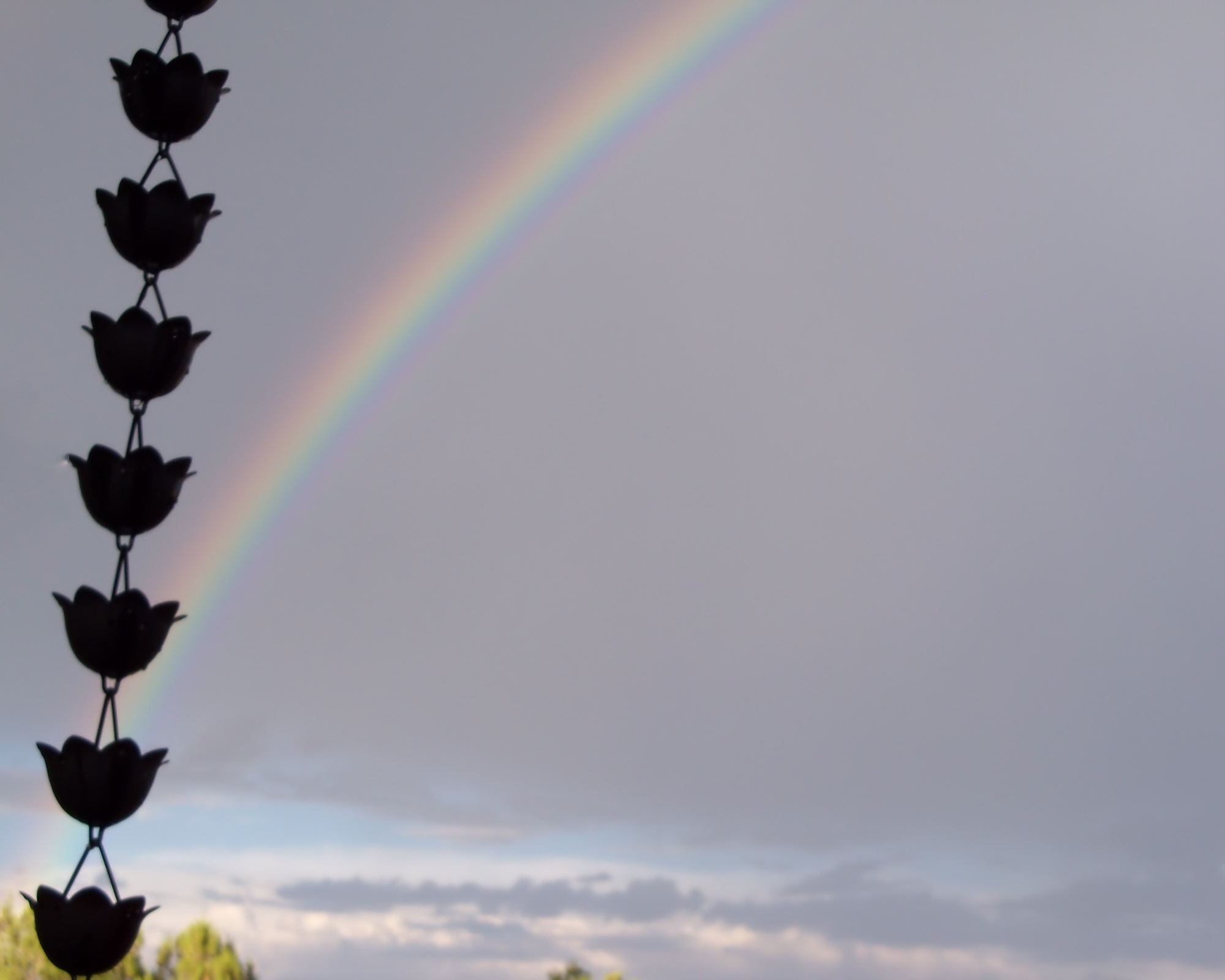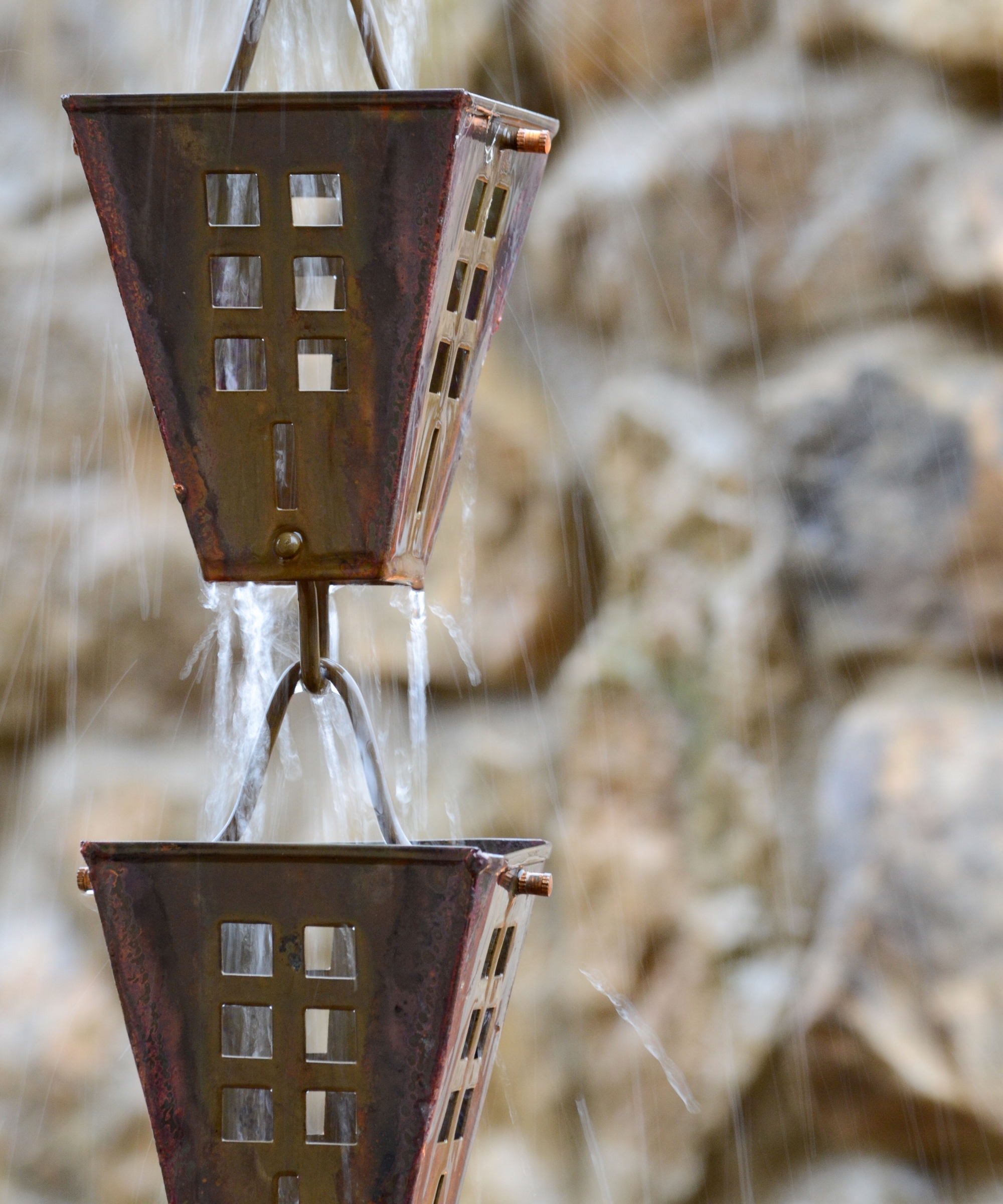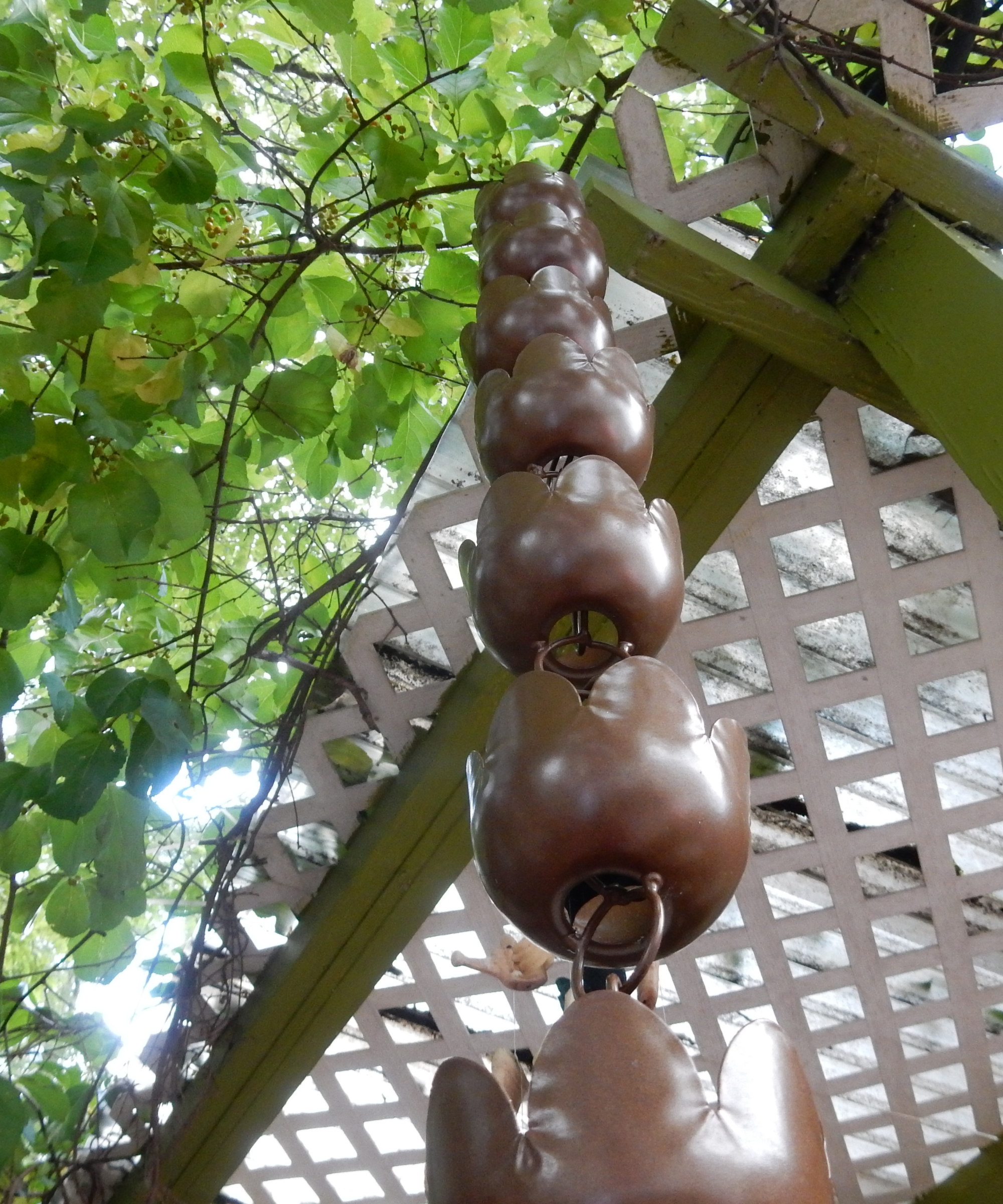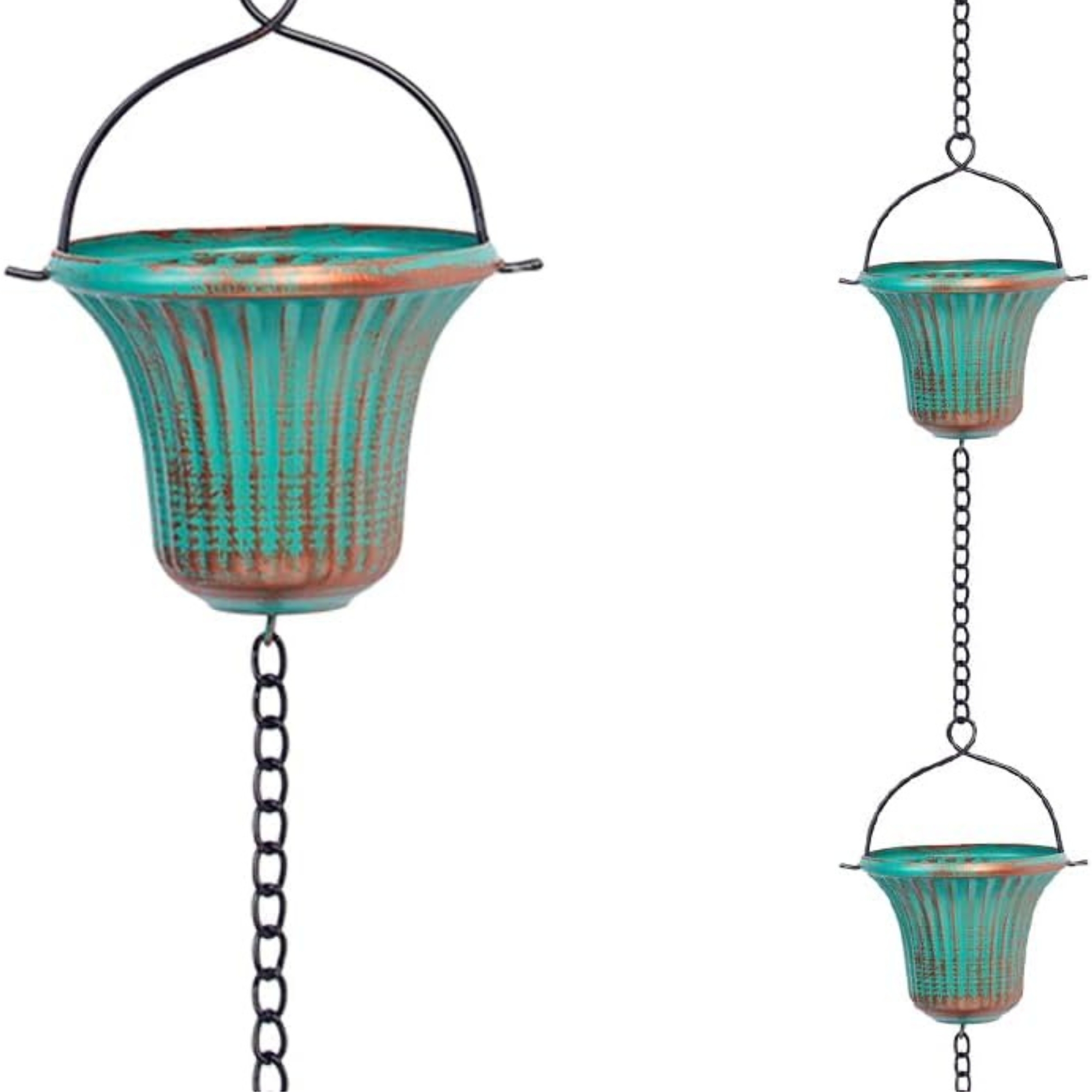
If you're tired of plastic guttering, asking 'what is a rain chain?' could get you the answers you've been looking for. This beautiful and functional downspout alternative can transform yours from drab to fab, with eco-conscious benefits to boot.
Our roofing and water-conservation experts explain what rain chains are, reveal the pros and cons, how to install one yourself and delve into more details in this guide to help you figure out if this way of harvesting rainwater is right for you, your outdoor space, and local weather.
Fancy giving this garden idea a go? Let's dive in.
What is a rain chain?
Nisha Maxwell, permaculture landscape designer and seed farmer explains rain chains are a "functional and decorative alternative to traditional downspouts, originating in Japan, where they are known as kusari-doi."
These nifty chains guide rainwater from the roof to the ground, creating both a visually appealing cascade, and a way to harvest rainwater.
Where our pros have suggested products, we've used our consumer, shopping, homes, and yard industry expertise to source suitable matching picks to help you shop the guide with high-quality products, from trusted retailers.
All prices were correct at the time of publication.
What are rain chains for?

In water-wise garden landscaping design, rain chains are used to harvest rainwater in an artistic way.
Nisha explains, "Rain chains work by directing rainwater through a series of connected links or cups, which act as small reservoirs. When it rains, water flows from the gutter into the top of the rain chain. Gravity pulls the water down the chain, and through surface tension slows the water’s descent and reduces splashing."
The water can then be collected in a rain garden, cistern (such as this 50-gallon water butt from Amazon that comes with a spigot for easy access, plus a five-star customer rating), or directed into a permeable garden bed at the base, ensuring it goes to good use instead of being wasted. Rain chains can be made of a simple chain, but are often intricate pieces of metal sculpture.
Jordan Woolf, owner of Huntsville Roofing Solutions adds, "Rain chains are decorative chains or series of cups, links, or decorative shapes that hang from the eaves of your roof and come in various materials including copper, brass, aluminum, and even ceramic, offering a range of styles to suit different architectural aesthetics."
Chris Stevenson, professional roofer of 730 South Exteriors adds, "Rain chains are an example of Japanese ingenuity and centuries old. Japan has many beautiful indoor and outdoor gardens, and rain chains were meant to add ambiance and look decorative at the same time."
Rain chains: The pros

The benefits of rain chains include their ability to conserve water by redirecting rainwater for reuse in gardens and reducing reliance on municipal water supplies.
Nisha explains, "Since the EPA estimates that 30% of Americans’ water use happens outdoors, saving rainwater could significantly reduce the household water bill. Rain chains are also beautiful, and beautiful green spaces not only make us happy but have been shown to reduce crime."
In addition to how aesthetically pleasing rain chains are, they can reduce your household carbon footprint and keep fresh water in the ecosystems where wildlife desperately needs it.
Chris highlights three other pros, including aesthetic beauty and soothing sounds, He says, "Your house looks more decorative every time you use a rain chain, which comes in many styles and is made out of different materials that can complement your house’s architecture as well as your landscaping.
"The sound of the buckets as the water trickles down the chain makes us feel at ease while working, relaxing, and enjoying the rain, whilst it helps to direct water into an empty barrel at the lower end, where it can be collected and used non-potable for plant watering."
Adrian Pedraza is the owner of The California Home Buyer, a professional house-flipping company, with over 10 years of experience buying, selling, and flipping properties in California. He keeps a close eye on all the changes in the real estate industry and home development and notes that rain chains are becoming more popular for homeowners.
He says, "One of the primary advantages of rain chains is their versatility in design and installation. Because they are available in so many different materials — from handcrafted ceramics to copper and aluminum — homeowners can easily incorporate them into a variety of architectural styles and personal preferences. Because of their adaptability, rain chains have become a popular option for homeowners looking to give their outdoor living spaces a little more personality and charm."
Rain chains: The cons

One of the pitfalls of rain chains is they become less effective in areas with heavy rainfall and may not be able to handle large volumes of water efficiently.
Nisha adds, "Strong winds can also disrupt the water flow. They can also clog more easily depending on the width of the openings and the amount of cups. Splashing can be more of an issue during a downpour than with a traditional downspout."
You can learn more about types of guttering in our guide.
To counter some of rain chain issues, you can try placing yours in areas collecting rain from a smaller roof area, such as an awning or balcony, whilst Adrian notes rain chains may not be the most suitable solution for areas with frequent heavy rainfall.
"Their limited water capacity can lead to overflow and water accumulation, potentially causing damage to the surrounding area," he explains. "For regions prone to heavy rainfall, homeowners may need to consider additional measures or explore alternative water management solutions to ensure proper drainage."
Chris details the other cons, including blockage and limited capacity. He says, "Rain chains have smaller openings than downspouts and can be more prone to clogging with leaves, debris, or even birds nesting in them. Regular cleaning is important to ensure proper drainage.
"In areas with high rainfall, rain chains may be ineffective because sometimes they won’t be able to handle the volume of water and can overflow; water can splash around the house in heavy downpours."
Be mindful too that some residential municipalities prohibit the use of rain chains. Check with your local building department before you buy to save your effort and time if this guttering tweak is not permitted where you live.
How to pick the right rain chain for you
When choosing a rain chain, consider the material and design.
Nisha says, "If you want to keep it simple and modern, you can hang a stainless steel chain. A copper chain is a more rustic option as it will develop a patina over time. If you want a piece of art, there are many pre-made rain chains available. I recommend finding a local metal artisan or perusing Etsy for something handmade."
We've enjoyed searching for beautiful rain chains and have picked three for their form and function, and explained our recommendations in our detailed product listings below.
Nisha adds that choosing a water collection method based on your region's annual rainfall can be helpful to help guide your pick.
She says, "Choose a garden bed for low rainfall, a water cistern for heavy rainfall, or a rain garden for intermittent heavy rain like southwestern monsoons. A rain garden is a dug-down planting bed in the shape of a depression, with deep-rooted plants that help absorb large amounts of water quickly to reduce flooding and erosion while charging the groundwater. Often, these serve as local wildlife playgrounds as well."

Price: From $36
Size (feet): 3.6
We like this floral design rain chain, which comes in three colors, as it has been made from recycled materials. The seller notes some of the additional elements used to make the piece might not be from sustainable materials or methods. We still think a lot of sellers doing some things in an eco-friendly way are better than no sellers doing anything sustainably and salute small businesses doing the best they can. This pretty rain chain has also been given five stars by all shoppers who reviewed their purchase, speaking to the item's quality. Etsy's Purchase Protection Programme gives shoppers refund rights on eligible shopping, helping you shop with confidence.

Price: $88.95
Size (feet): 8.5
This hammered, high-quality copper rain chain can be installed easily from your gutter, comes highly rated by shoppers, and can be extended by 3ft if you need or want further cups for your down-spout needs. This lengthy rain chain features 15 large cups that have been hand-hammered by artisan chain makers, and over time, the copper will develop a lovely rustic brown patina, adding further style to function. The item is rust-resistant and made from heavy-gauge pure copper, meaning thick sheets were used to make these. You can buy the extensions and matching basin alongside this item for aesthetic cohesion.

Price: $35.99
Size (feet): 11
Lengthy copper chain will be the perfect length when hanged from most one story homes, and comes with 12 cups but these can be removed or adjusted to suit the dimensions you need in your outdoor space. Made from copper, this rain chain also have a weighted bell at the bottom to help counter excessive movement during wind, and reducing splashing, which some rain chains can be prone to due to their usually un-anchored form. This item has a protective paint layer to ensure it's longevity, and is highly-rated by shoppers on Amazon, who note that it looks pretty in person and is easy to install.
How to install a rain chain

To install, first remove your downspout (the pipe connecting your roof to the ground drain). This is a good time to also clean your gutters.
Nisha advises, "Install a wide outlet to prevent clogging, secure a rain chain bracket or hook above it, and thread the chain through, ensuring the bottom is anchored to prevent wind damage. This can be done with a cemented bolt or by burying the bottom part in stone."
You may need additional hardware or a special hanger to secure the rain chain to the gutter, explains Jordan.
If the rain chain you've purchased doesn't have what you need, take it along to a hardware store and ask for help from the staff in store to decide the best way to fix it on. They may find it helpful to see images of your gutter and roofing so snap those before you head to a hardware store in person.
Jordan adds, "Ensure that the rain chain hangs freely and reaches the desired area for water drainage."
What to put at bottom of a rain chain
Roofer Chris recommends popping a splash block at the bottom of a rain chain to disperse the water flow. He says. "This will prevent erosion around your foundation. You can find pre-made splash blocks or create one using flat stones or pavers."
Try the cheap and cheerful Rubberific splash block from Lowe's which won't chip or crack, whilst nicely blending into to your yard aesthetic with four colorways.
You can alternatively attach a rain barrel to the end of the chain to catch rainwater for later use, or as Jordan details, you can use a basin or pebbles at the bottom to control water flow and prevent erosion.
Walmart stocks PGN White River Rocks which are not only gorgeous but come in 15lb bags so you can use what you need underneath your rain chain, then style the remainder elsewhere for aesthetic cohesion. You can also purchase more bags to tie in the chic look in your patio paver area, or to line a section of path in your backyard ideas.
Rain chain maintenance tips
The bulk of the maintenance for rain chains falls into two categories: clearing debris, and preparing for winter.
Adrian explains, "In general, it is safe to leave rain chains outside during the winter as long as the right safety measures and upkeep are taken. Freezing and icing can happen in colder climates, which could harm the chain or obstruct water flow."
He advises cleaning the rain chain thoroughly when preparing your garden for winter and inspecting it to make sure it is clear of debris and capable of operating as intended. He adds, "You can shield metal chains from the harsh winter weather by coating them with a rust-resistant substance."
Try Rust-Oleum's Stop Rust Inhibitor Spray, available on Amazon on untreated metal. It's easy spray application will make protecting your rain chain and other outdoor metal items a cinch, and protect them for six months.
Adrian also suggests installing a snow load-rated rain chain, or one with an integrated ice guard for homeowners who live in heavily snowed areas. "These unique designs are made to resist the weight of snow accumulation and stop ice from forming, guaranteeing continuous water flow all winter long," he says.
Ryan Farley, CEO of LawnStarter heeds a warning about rain chains potentially damaging your gutter. He says, "I recommend removing your rain chain in the winter, unless you live in an area with pretty mild winters. If ice builds up on your rain chain, it could actually cause damage to your gutter due to weight dragging on the structure."
Meet our experts
Now you're in the zone for gardening ideas, pick up pretty garden border ideas to compliment your new rain chain.







